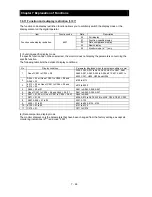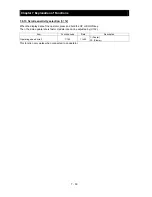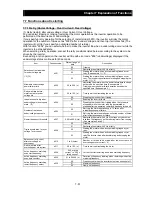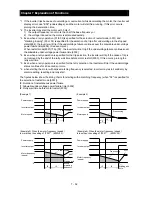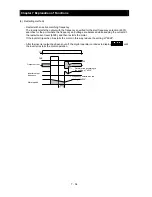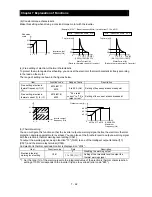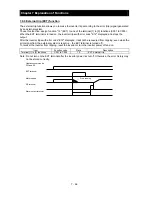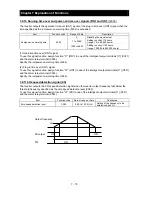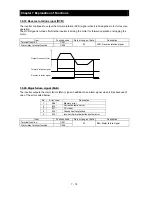
Chapter 7 Explanation of Functions
7 - 61
7.8.2 Electronic thermal protection
The electronic thermal protection function allows you to protect the motor against overheating. Make
settings of this function based on the rated current of the motor. The inverter will trip for overheat protection
according to the settings.
This function provides optimum overheat protection that is also designed with the lowering of the motor's
cooling performance at low speeds in mind.
You can configure this function so that the inverter outputs a warning signal before it trips for electronic
thermal protection.
(1) Electronic thermal level
Item
Function code
Range of data
Description
Electronic thermal
setting (calculated within
the inverter from current
output)
b012/b212
"0.2 x rated current" to
"1.0 x rated current"
See the example below.
(2) Electronic thermal characteristic
The frequency characteristic set as the electronic thermal characteristic is integrated with the value of
"b012" or "b212".
The cooling-fan performance of a general-purpose motor lowers when the motor speed is low. So load
(current) is decreased.
The reduced-torque characteristic is designed to match the heat generation by Hitachi's general-purpose
motors.
Item Function
code
Data
Description
Electronic thermal
characteristic
b013/b213
00 Reduced-torque
characteristic
01 Constant-torque
characteristic
02
Free setting of electronic thermal characteristic
(a) Reduced-torque characteristic
The time-limit characteristic determined by the value of "b012" or "b212" is integrated with each frequency
multiplied by reduction scales.
X1.0
5 16
50
X0.8
X0.6
0
6
20
60
0
Base frequency
Inverter output
frequency (Hz)
Reduction
scale
Trip time(s)
Motor current (A)
(Ratio to the
rated current of
inverter)
60
3.0
0
200%
150%
109%
7.7
(109%)
10.7
(150%
)
14.2[A]
(200%)
0
60
3.0
Trip time (s)
(Example) 015L**, Base frequency60Hz,
(
rated current7.1A = b012
)
60Hz
(
Reduction scale
:
x1.0
)
6.2
(87.2%)
8.5
(120%
)
11.4[A]
(160%)
0
60
3.0
20Hz
(
Reduction scale
:
x0.8
)
Trip time (s)
Motor current (A)
(Ratio to the rated current of inverter)
Motor current (A)
(Ratio to the rated current of inverter)
Summary of Contents for NES1-002LB
Page 9: ......
Page 21: ......
Page 25: ......
Page 28: ...Chapter 3 Exterior Views 3 3 ...
Page 30: ......
Page 35: ......
Page 53: ......
Page 75: ......
Page 154: ......
Page 196: ......
Page 203: ...Chapter 10 Troubleshooting This chapter describes the troubleshooting methods ...
Page 204: ......
Page 211: ......
Page 219: ......
Page 229: ......
Page 289: ...Appendix Appendix A Appendix A 1 ...
Page 290: ......
Page 292: ...Appendix Appendix 2 ...


